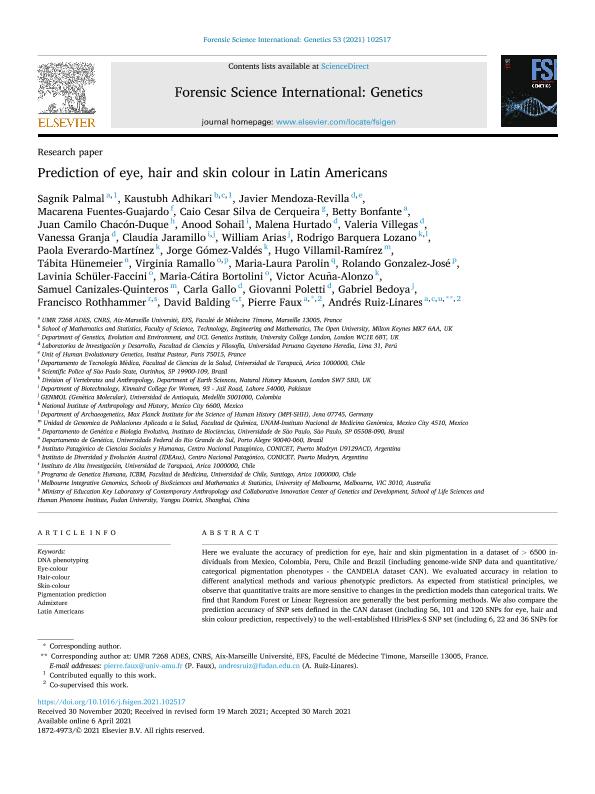Artículo
Prediction of eye, hair and skin colour in Latin Americans
Palmal, Sagnik; Kaustubh Adhikari; Mendoza Revilla, Javier; Fuentes Guajardo, Macarena; Silva de Cerqueira, Caio Cesar; Bonfante, Betty; Chacón Duque, Juan Camilo; Sohail, Anood; Hurtadeo, Malena; Villegas, Valeria; Granja, Vanessa; Jaramillo, Claudia; Arias, Williams; Barquera Lozano, Rodrigo; Everardo Martínez, Paola; Gómez Valdés, Jorge; Villamil Ramirez, Hugo; Hünemeier, Tábita; Ramallo, Virginia ; Parolin, María Laura
; Parolin, María Laura ; Gonzalez, Rolando Jose; Schüler-Faccini, Lavinia; Bortolini, María Cátira; Acuña Alonzo, Victor; Canizales Quinteros, Samuel; Gallo, Carla; Poletti, Giovanni; Bedoya, Gabriel; Rothhammer, Francisco; Balding, David; Faux, Pierre; Ruiz Linares, Andrés
; Gonzalez, Rolando Jose; Schüler-Faccini, Lavinia; Bortolini, María Cátira; Acuña Alonzo, Victor; Canizales Quinteros, Samuel; Gallo, Carla; Poletti, Giovanni; Bedoya, Gabriel; Rothhammer, Francisco; Balding, David; Faux, Pierre; Ruiz Linares, Andrés
 ; Parolin, María Laura
; Parolin, María Laura ; Gonzalez, Rolando Jose; Schüler-Faccini, Lavinia; Bortolini, María Cátira; Acuña Alonzo, Victor; Canizales Quinteros, Samuel; Gallo, Carla; Poletti, Giovanni; Bedoya, Gabriel; Rothhammer, Francisco; Balding, David; Faux, Pierre; Ruiz Linares, Andrés
; Gonzalez, Rolando Jose; Schüler-Faccini, Lavinia; Bortolini, María Cátira; Acuña Alonzo, Victor; Canizales Quinteros, Samuel; Gallo, Carla; Poletti, Giovanni; Bedoya, Gabriel; Rothhammer, Francisco; Balding, David; Faux, Pierre; Ruiz Linares, Andrés
Fecha de publicación:
07/2021
Editorial:
Elsevier Ireland
Revista:
Forensic Science International: Genetics
ISSN:
2041-1723
e-ISSN:
1872-4973
Idioma:
Inglés
Tipo de recurso:
Artículo publicado
Clasificación temática:
Resumen
Here we evaluate the accuracy of prediction for eye, hair and skin pigmentation in a dataset of > 6500 individuals from Mexico, Colombia, Peru, Chile and Brazil (including genome-wide SNP data and quantitative/categorical pigmentation phenotypes - the CANDELA dataset CAN). We evaluated accuracy in relation to different analytical methods and various phenotypic predictors. As expected from statistical principles, we observe that quantitative traits are more sensitive to changes in the prediction models than categorical traits. We find that Random Forest or Linear Regression are generally the best performing methods. We also compare the prediction accuracy of SNP sets defined in the CAN dataset (including 56, 101 and 120 SNPs for eye, hair and skin colour prediction, respectively) to the well-established HIrisPlex-S SNP set (including 6, 22 and 36 SNPs for eye, hair and skin colour prediction respectively). When training prediction models on the CAN data, we observe remarkably similar performances for HIrisPlex-S and the larger CAN SNP sets for the prediction of hair (categorical) and eye (both categorical and quantitative), while the CAN sets outperform HIrisPlex-S for quantitative, but not for categorical skin pigmentation prediction. The performance of HIrisPlex-S, when models are trained in a world-wide sample (although consisting of 80% Europeans, https://hirisplex.erasmusmc.nl), is lower relative to training in the CAN data (particularly for hair and skin colour). Altogether, our observations are consistent with common variation of eye and hair colour having a relatively simple genetic architecture, which is well captured by HIrisPlex-S, even in admixed Latin Americans (with partial European ancestry). By contrast, since skin pigmentation is a more polygenic trait, accuracy is more sensitive to prediction SNP set size, although here this effect was only apparent for a quantitative measure of skin pigmentation. Our results support the use of HIrisPlex-S in the prediction of categorical pigmentation traits for forensic purposes in Latin America, while illustrating the impact of training datasets on its accuracy.
Archivos asociados
Licencia
Identificadores
Colecciones
Articulos(IDEAUS)
Articulos de INSTITUTO DE DIVERSIDAD Y EVOLUCION AUSTRAL
Articulos de INSTITUTO DE DIVERSIDAD Y EVOLUCION AUSTRAL
Articulos(IPCSH)
Articulos de INSTITUTO PATAGONICO DE CIENCIAS SOCIALES Y HUMANAS
Articulos de INSTITUTO PATAGONICO DE CIENCIAS SOCIALES Y HUMANAS
Citación
Palmal, Sagnik; Kaustubh Adhikari; Mendoza Revilla, Javier; Fuentes Guajardo, Macarena; Silva de Cerqueira, Caio Cesar; et al.; Prediction of eye, hair and skin colour in Latin Americans; Elsevier Ireland; Forensic Science International: Genetics; 53; 7-2021; 1-12
Compartir
Altmétricas



